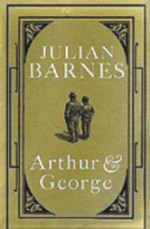|
Book
Review
Show me the way to go, Holmes
Tim Adams
Julian Barnes has always fancied a detective yarn. In the 1980s, he used to have a go at them himself, under the pseudonym of Dan Kavanagh, who wrote calculatedly hard-boiled tales about Duffy, a bisexual ex-cop on the trail of vice and murder in Soho. At the time, Barnes used to explain this sideline by saying it came from a different part of his head from the grown-up cleverness of Flaubert's Parrot or A History of the World in 10½ Chapters; it was a holiday job.
For Arthur & George, you might say that the author has combined for the first time those two halves of his brain, taken his rigour on vacation. With characteristically engaging intelligence, he has climbed into the mind of the most celebrated detective writer of all, Sir Arthur Conan Doyle, and set off on an adventure.
His novel begins as a pair of alternating biographies, a tale of opposites. On the one hand, a boy full of dreams, the young Conan Doyle, listening to Arthurian legend in his mam's Scottish kitchen, a promising athlete and scholar, the classroom wit and storyteller; on the other, a boy stripped of imagination, one George Edalji, son of a vicar in rural Staffordshire, poor and myopic, friendless and stolid.

Arthur & George Julian Barnes |
Any student of Conan Doyle, or decent Sherlockologist will know that these two names became linked in later life. George Edalji, who trained as a solicitor, was the victim of a famous miscarriage of justice, convicted in 1903 of mutilating livestock in his parish. After his release from a seven-year prison sentence, it was Conan Doyle who championed his case for a pardon in the newspapers and in parliament. The writer was asked many times in his life to put on Holmes's cloak and solve a mystery himself; the Edalji case was the only time he agreed.
For much of the book, Barnes cuts quickly between these two fates - a page on Arthur, one on George - meticulously mapping their journey before they finally meet. You might expect along the way, from this author, some trickery, but Barnes seems more concerned here with an absolute formal clarity.
His prose, and, particularly, his facility with dialogue, is a kind of homage to the stateliness of late Victorian letters and, in particular, to the creator of Sherlock Holmes, whose great gift was his ability to embed his narrative in speech. Barnes quotes Conan Doyle at one point on the subject of writing, as if as a statement of intent: 'Firstly, to be intelligible, secondly, to be interesting, and thirdly, to be clever.' Though this formality of tone gives the whole an antique air, enhanced by the retro, buff, cloth covers of the Jonathan Cape edition, Arthur & George come quickly to life.
For all the numerous retellings of Conan Doyle's life, it is hard to imagine that Barnes's semi-fictional version could be bettered in texture or acuity. In his elegant mini-chapters, he unpacks the writer's extraordinary rites of passage: his famous failure as an ophthalmologist; his work on a whaling ship; his sporting prowess - batting for the MCC, skiing Alpine passes; his heroism in the Boer War.
Barnes has a sure feel for Conan Doyle's sense of propriety and duty - 'He has loved [his wife] as best he can,' he writes, 'given that he did not love her' - and for the challenges to it in the form of his lover, Jean Leckie.
While Arthur is exerting his considerable influence on the world, George, a kind of rural Bartleby, is passing through life almost unnoticed. He is at school before he realises one of the reasons for this when one boy whispers to him: 'You're not a right sort.' George's father is Indian, a Parsee, who has married the daughter of a Scottish vicar, and has taken over the parish church in Great Wyrley. Set apart by his race, George is further estranged by his terrible eyesight. He sleeps and prays in his father's bedroom and devotes himself to his study of the law relating to the railways.
Barnes recreates George's restricted view of his provincial world with great care and formidable research, and it is thus all the more affecting when he is accused of crimes which he could hardly comprehend, let alone commit.
In prison on remand, George reads some of Conan Doyle's shilling shockers as well as The Hound of the Baskervilles. It is Conan Doyle's indelible creation who hovers in the background when the pair meet, too, a fact that troubles the author, who felt ambivalence towards his mercurial alter ego throughout his life: his access to the main players in this case, and to their psychology was 'largely thanks to Holmes, although thanking Holmes did not come easily to Arthur'.
The fictional detective would have been proud of his creator none the less for piecing together the parts of a mystery that had confounded the police. He would perhaps, too, have been rather impressed with Julian Barnes, who has taken the bones of a long-dead history and imbued them with vivid and memorable life.
Source: The Guardian
Copyright
(R) thedailystar.net 2005 |
